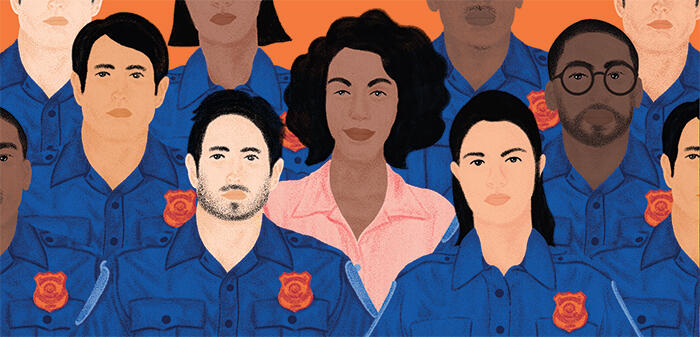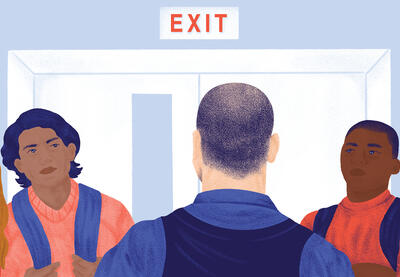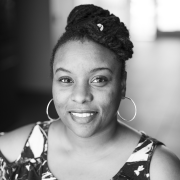On June 2, 2020, eight days after the killing of George Floyd in Minneapolis, Minnesota, Minneapolis Public Schools (MPS) voted to end its contract with the Minneapolis Police Department. Floyd’s public death had hit Minneapolis students hard. Young people there had long urged school officials to cut ties with police. Now that police were responsible for the brutal murder of yet another Black man in their community, that demand became more tenable.
Following the murder, protesters in Minneapolis and around the country rallied for either defunding or abolishing police. Minneapolis students and many community members concentrated on school resource officers (SROs). The majority of the MPS population comprises students of color, some of whom were tear-gassed during the 2020 protests.
Nathaniel Genene, now a 2021 graduate from a Minneapolis high school, was a student representative on the school board at the time. He emailed local school officials and reached out to fellow students to build solidarity around ending police presence in Minneapolis schools. “I realized that we couldn’t have a safe culture … in our schools with an MPD officer in that building,” Genene says. “We want to invest in students, not cops.” Other large school districts across the country have also cut ties with police. The school board in Seattle, Washington, suspended its police contract for a year. District contracts with police were fully terminated in Denver, Colorado; Milwaukee and Madison, Wisconsin; Portland, Oregon; San Francisco and Oakland, California; and Rochester, New York. Efforts to do likewise are also happening in smaller communities and in the South, in such places as Gwinnett County, Georgia.
Activists say it takes years of organizing to establish police-free schools, and some community members say police-free schools aren’t a one-size-fits-all solution. But with activism and multigenerational engagement, school communities have reimagined and can reimagine safety without police presence.
Feeding the School-to-Prison Pipeline
Schoolyard fights, childish pranks and tantrums used to result in a visit to the principal’s office. Today, however, code of conduct violations can end with students in handcuffs. Juvenile and adult courts then become inundated with children who pose no real threat in their communities.

Latrice Johnson, of Montgomery, Alabama, can attest—as a former student and now as a parent—how police intimidate or react violently to students. Her son faced criminal charges after getting into a school fight when he was 16. The charge was eventually thrown out, but it created stress on the family. “Kids will be kids, but take the time out and don’t just try to send them to juvenile or suspend them. There are alternatives today,” she says.
Many students, parents and community members say school police have been ineffective. Studies have shown that SROs don’t reduce crime but cause harm instead—including increased arrests, expulsions, physical restraint and the kind of family stress that Johnson describes.
Florida is one case study in the harm SROs create. There are more police in Florida schools than nurses. And the number of SROs there is more than double that of school psychologists and social workers, according to the ACLU of Florida report The Cost of School Policing: What Florida’s Students Have Paid for a Pretense of Security, a collaborative project of several social justice organizations.
The study found that “during the 2018-2019 school year, the number of youth arrests at school increased 8%, while the number of youth arrested in the community continued to decline by 12%.” The number of students expelled or physically restrained also increased significantly. This includes younger children too. Florida SROs arrested elementary-age students 345 times during the 2018-2019 school year.
According to the same report, there was no consistent evidence that an increase in SROs at schools decreased the number of behavioral incidents. In other words, SROs don’t necessarily improve school safety.
You’re teaching them how to go to jail. You’re desensitizing them to being criminally involved. This is all part of the whole prison industrial complex.
— Marlyn Tillman
Pulling SROs into issues regarding arbitrary school rules is common—and it disproportionately affects students of color. Gwinnett County, Georgia, parent and activist Marlyn Tillman knows this firsthand. She says that in 2003, a teacher targeted her son for his self-styled clothing and engaged an SRO to enforce the dress code. Her son was suspended. Tillman sued the school district and, in 2006, settled the case.
Then Tillman and other parents organized to create the Gwinnett Parent Coalition to Dismantle the School to Prison Pipeline (Gwinnett SToPP) in 2007. While working with school administrators to modify the district’s code of conduct policies, she noticed language that was similar to criminal codes.
“‘You’re teaching them how to go to jail,” she recalls telling an administrator. “‘You’re desensitizing them to being criminally involved. This is all part of the whole prison industrial complex.’ And this was when I was starting to do this work.”
The effects of this kind of harm on Black girls are significant. Recent research shows that the adultification of Black girls often leads to contact with police and entry into the school-to-prison pipeline. Tawanda Morgan, a former teacher who now provides diversity, equity and inclusion training for educators in Alabama, highlights this issue and hopes to obtain funding for additional research.
Pointing to the work of social justice scholars like Dr. Kimberlé Williams Crenshaw, Dr. Monique W. Morris and Dr. Jamilia Blake, Morgan says Black girls are often left out of the conversation because, historically, Black women have always been brutalized, sexualized and erased. That is a reason to focus more on their protection.
Protection of the most marginalized students takes priority as communities rethink what school safety means.
Valuing Students’ Humanity and Mental Health
Student activists often repeat the refrain, “Counselors, not cops,” which has become a national movement. Schools generally lack enough counselors or referrals for mental health services. According to the American School Counselor Association (ASCA), the national average student-to-counselor ratio is 424-to-1. ASCA recommends a ratio of 250-to-1.
Yet, say advocates for police-free schools, most behavioral issues are best alleviated with nonpunitive practices and the help of mental health professionals. “[We should be] seeking more restorative practices so that we can create more of a healing environment for students,” Morgan says.
Even parents who aren’t completely sold on removing all police from schools see the value in prioritizing mental health services and alternative safety measures. In Birmingham, Alabama, Tyrone King says that, while he has no problem with SROs, community engagement could reduce the need for police. King, the father of an elementary student in Birmingham City Schools, belongs to a group of fathers who monitor schools in the mornings as their schedules allow. They also work to build rapport with principals and other school staff.
King says he respects police officers in his community but recognizes that they aren’t trained to provide the types of support students need. And he acknowledges that police officers often evoke anxiety in students of color. “Most law enforcement officers aren’t trained in that area or have no social work background, and some of them aren’t even parents,” King says.
Latrice Johnson thinks schools should do more to address bullying and the mental health needs of students to prevent students from reacting in violent ways. “They would rather send your child to prison than get your child mental stability,” she says. “I feel [the education system] wasn’t designed for [Black people]. We were just included.”
A Movement Is Born in Oakland
In Oakland, California, community members worked for decades to reimagine their education system with a focus on police-free schools. Since 1957, when Oakland Unified School District (OUSD) established its own police force, groups from the Northern California chapter of the NAACP to the Black Panther Party have opposed police presence at schools.
Recent opposition has come from Black Organizing Project (BOP), established in 2009 to create safe spaces for Black community members to address systemic issues.
During BOP’s early years, a national “post-racial” narrative had formed following the 2008 election of President Barack Obama. But in 2009, Oscar Grant, a 22-year-old Black man, had been killed by an Oakland transit cop, which garnered national attention. Two years later, in a reaction to gang violence, Oakland city officials established gang injunctions, which restricted the activities of people identified as gang members.
Local activists argued that these injunctions would increase police profiling, violate citizens’ civil rights and create an environment that would lead to more deaths.
“A lot of criminalization was happening while there was a mainstream narrative that, ‘Oh, Barack Obama is in office—everything is changing,’” says Jasmine Williams, BOP spokesperson. “While there was this image of progress in the streets and in the most impacted communities, our people were still dying at the hands of police violence.”

Planning and Persistence
Already organizing against police violence, BOP members launched the Bettering Our School System (BOSS) campaign after the 2011 killing of Raheim Brown Jr., a young Black man, by an Oakland school police officer.
BOP knew that their fight could result in dismantling the school-to-prison pipeline. They were not interested in police reform; they wanted abolition. However, they knew they had to accept small wins first.
They pushed district officials to shift some money from the police budget into restorative justice practices. They also created a complaint policy for teachers, students, parents and caregivers to ensure that school police were held accountable.
BOP’s ultimate goal was to remove police from Oakland schools by 2020. In March 2020, they presented Oakland USD board members with a resolution—two months before Floyd’s murder. The resolution lost.
After Floyd’s death, BOP received an outpouring of support. They regrouped with parents, caregivers and students to implement 10 Days of Action: a campaign to get school board members and city officials to support another resolution to remove police from schools. “We amped it up,” Williams says. “We really had to make sure that they felt the pressure so that they would vote right this time.”
On June 24, 2020—after a nine-year struggle—the Oakland USD board unanimously voted to eliminate its 67-member police force. They also agreed to reinvest the force’s multimillion-dollar budget in an alternative safety plan and other student resources.
Engagement with district officials, examining data and multigenerational organizing helped BOP members better inform the community’s push toward abolition. But it was an uphill battle. While BOP found solidarity with allied groups in Los Angeles and Denver, they had to work harder in Oakland to realize their vision of police-free schools there.
“People didn’t think it was possible,” Williams says. “People felt safer going for reform or talking about cultural and climate sort of stuff, which are all very necessary for the whole ecosystem. But abolition of police in schools was not necessarily a mainstream conversation or something easy for people to swallow in the beginning stages.”
The Value of Student-led Efforts
When Nathaniel Genene began organizing around police-free schools in Minneapolis, some school administrators told him there were other priorities. But as the 2020 uprising accelerated in the city, Genene says, he had to do something.
“Every three years we would have this conversation of what it means to feel safe, how to keep students safe, how to keep buildings secure,” Genene reflects. “Last year, it kind of became more, ‘Are we going to morally align with the MPD or are we going to invest in an institution that is literally traumatizing our students day in and day out?’”
He and a friend from another high school gathered feedback from students in the district and collected more than 1,800 responses to an online survey. Genene and his friend presented their findings during the board meeting at which members ultimately voted to end the school system’s police contract.
Genene’s organizing had been done while students were at home doing distance learning. The strong response showed the power of technology to connect young people with a common goal. He later received thousands of emails from people around the country who wanted to emulate that kind of effort in their communities.
Looking Ahead
For parents like Latrice Johnson and Tyrone King, questions linger about solutions for school safety. But like others who advocate for the removal of SROs, they agree that school communities must take action to ensure students’ safety.
There are signs that the police-free school movement continues to build steam. Activism among students and the broader community has inspired new bills at state and federal levels. According to the Movement for Safe and Just Schools Map, dozens of schools, community groups and organizations are mobilizing to reimagine safety at school without police. At least 24 communities have passed measures to remove SROs.
Some members of the U.S. House of Representatives and the U.S. Senate have worked together to reintroduce the Counseling Not Criminalization in Schools Act (defeated in the last Congress), which would, in part, divert money from school-based policing to trauma-informed services. A bill that would remove police from schools has been proposed in the Maryland Legislature. Massachusetts has ended its requirement for police in schools. Similar local-level proposals are in play around the nation.
Jasmine Williams of BOP reminds us that creating a safe and just school community won’t happen overnight. Small wins, losses and concessions will happen along the way. “These systems were built hundreds and hundreds of years ago,” she says. “It puts you in a place to understand that this is not going to be a quick fight. And one policy isn’t ... going to fix it all.”

